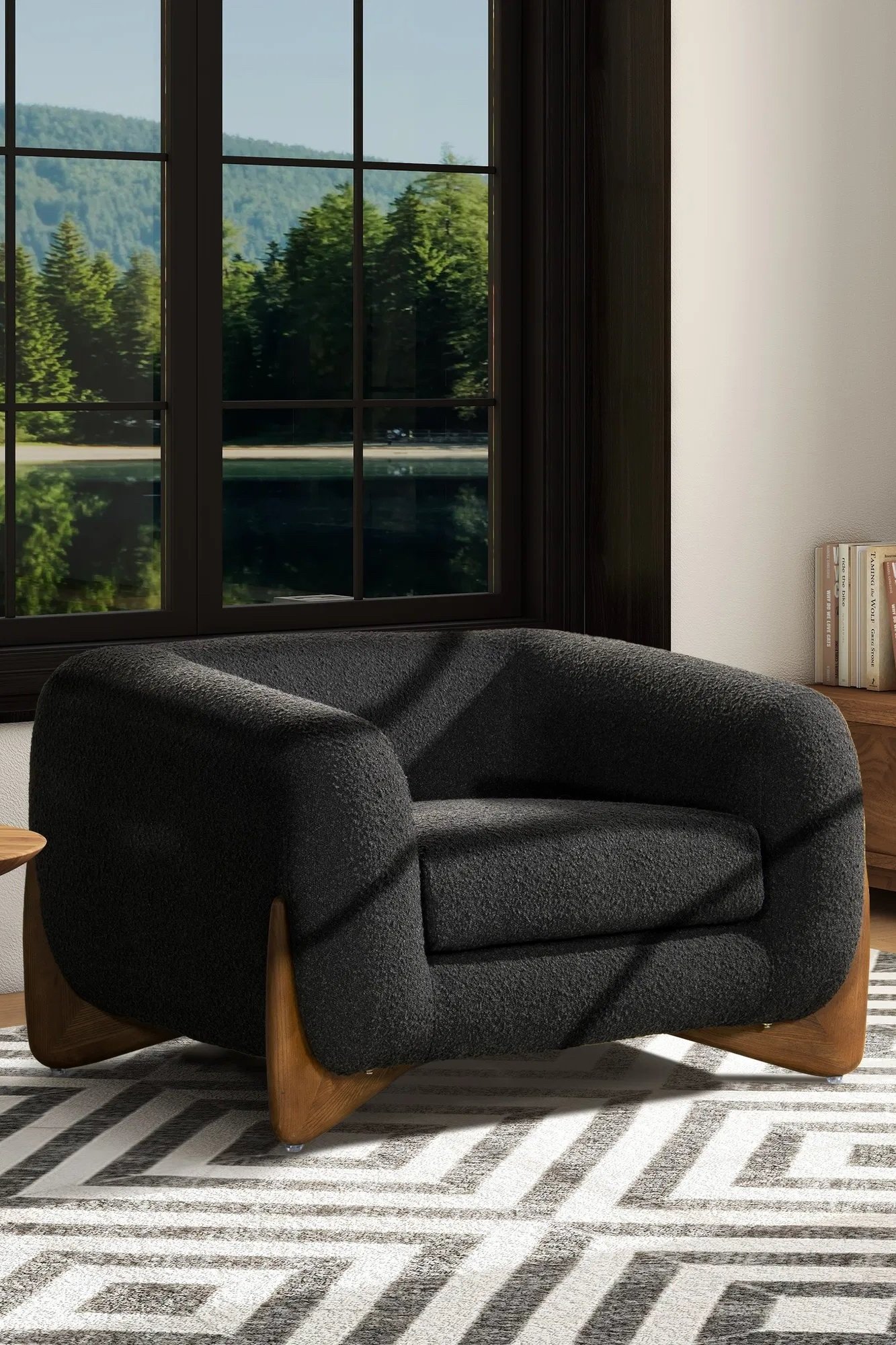 Image 1 of 4
Image 1 of 4

 Image 2 of 4
Image 2 of 4

 Image 3 of 4
Image 3 of 4

 Image 4 of 4
Image 4 of 4





São Paulo Ivory Armchair
Details
Modern, chic and stylish, our São Paulo Ivory Armchair is a gorgeous addition to any decor. Minimalist in aesthetic and modern in design, this versatile accent chair is the perfect companion for your living room, bedroom, office, or dining room. A steel metal frame covered black coating provides the basis for the chair's sturdy construction. The seat and back are covered in soft Chenille fabric and filled with thick, high-density foam for a cozy experience. This exquisite accent chair fits effortlessly into just about any room or design, a wonderful finishing touch that offers a new level of style.
Editors' Note
This collection is named for São Paulo, Brazil, which in 1922 hosted the Semana de Arte Moderna, a week-long festival that marked the birth of Brazilian Modernism, an aesthetic reflected in this piece. In many ways contemporary with Modernist movements in the United States and Europe, the creation of a specifically Brazilan perspective was seen at the time as a crucial step in defining a sense of Brazilian-ness that was distinct and separate from the identities of the nation's European colonizers. It is perhaps ironic then that so much of the style was inspired and championed by European architects such as the Swiss-French, Le Corbusier, Italian-born Lina Bo Bardi, and Jorge Zalszupin, originally from Poland, who only arrived in Brazil following WWII. In fact, it was a maxim of Brazilian-born poet and novelist José Oswald de Souza Andrade and his wife, the modernist painter Tarsila do Amaral, that in the process of creating something unique to Brazil, its creatives should “cannibalize” the cultures and aesthetics of other nations. The notion gave rise to a movement known as the Anthropophagics — "the Cannibals." Perhaps as a result, Brazilian Modernism enjoys several points of overlap with its European and American cousins. All three share a focus on simplified designs, drawing inspirations from organic and geometric shapes, while combining form and function in a seamless union. To distinguish itself, therefore, Brazilian Modernism emphasized the natural splendor and resources of the Brazilian landscape, while also embracing the strong influence that African and Indigenous cultures had and continue to have on Brazilian culture. However, as Brazilian power structures and ideologies of race were strongly formed by those imported with European colonizers, and continued largely to adhere to them following independence, this embrace more often reflected racist misconceptions of Indigenous and African cultures, as indicated by the reference to 'cannibalism' — an inaccurate stereotype levied against Indigenous people in Brazil since the 16th century. The 1923 painting, "A Negra," by Tarsila do Amaral is indicative of this trend, displaying an exoticized image of a nude Black woman, with exaggerated features such as oversized lips and large, sagging breasts that resonates with longstanding stereotypes. Conversely, Emiliano di Cavalcanti’s 1930 painting, “Cinco Moças de Guaratingeutá” (Five Girls from Guaratinguetá), which depicts five fashionable young women enjoying time out on the town, has been questioned for presenting an idealized image of a racially equitable society that was (and is) far removed from the realities of life for non-white Brazilians then and now. Like other Modernisms, Brazilians Modernism was a far-reaching philosophy, the impact of which was felt in a variety of creative fields from architecture and art to literature and furniture design. Visionary pieces such as Sérgio Rodrigues’ Mole chair, and Brazilian Rosewood sofas designed by Brazilian architect, Oscar Neimeyer gained wide acclaim, influencing, as much of Brazilian Modernism did, design aesthetics across the rest of the world. By the late 20th century, new narratives of Brazilian Blackness were emerging, bolstered by expressions in late-modernist art. In 1975, inspired by the American Civil Rights Movement, artist-activists in Brazil created works that amalgamated symbols from U.S. and African liberation movements with those of Afro-Brazilian culture and religious traditions. These works carried the twin goals of exposing and denouncing systemic racism in Brazil and reclaiming the narrative of Blackness, redefining it both in Brazil and beyond.
Details
Modern, chic and stylish, our São Paulo Ivory Armchair is a gorgeous addition to any decor. Minimalist in aesthetic and modern in design, this versatile accent chair is the perfect companion for your living room, bedroom, office, or dining room. A steel metal frame covered black coating provides the basis for the chair's sturdy construction. The seat and back are covered in soft Chenille fabric and filled with thick, high-density foam for a cozy experience. This exquisite accent chair fits effortlessly into just about any room or design, a wonderful finishing touch that offers a new level of style.
Editors' Note
This collection is named for São Paulo, Brazil, which in 1922 hosted the Semana de Arte Moderna, a week-long festival that marked the birth of Brazilian Modernism, an aesthetic reflected in this piece. In many ways contemporary with Modernist movements in the United States and Europe, the creation of a specifically Brazilan perspective was seen at the time as a crucial step in defining a sense of Brazilian-ness that was distinct and separate from the identities of the nation's European colonizers. It is perhaps ironic then that so much of the style was inspired and championed by European architects such as the Swiss-French, Le Corbusier, Italian-born Lina Bo Bardi, and Jorge Zalszupin, originally from Poland, who only arrived in Brazil following WWII. In fact, it was a maxim of Brazilian-born poet and novelist José Oswald de Souza Andrade and his wife, the modernist painter Tarsila do Amaral, that in the process of creating something unique to Brazil, its creatives should “cannibalize” the cultures and aesthetics of other nations. The notion gave rise to a movement known as the Anthropophagics — "the Cannibals." Perhaps as a result, Brazilian Modernism enjoys several points of overlap with its European and American cousins. All three share a focus on simplified designs, drawing inspirations from organic and geometric shapes, while combining form and function in a seamless union. To distinguish itself, therefore, Brazilian Modernism emphasized the natural splendor and resources of the Brazilian landscape, while also embracing the strong influence that African and Indigenous cultures had and continue to have on Brazilian culture. However, as Brazilian power structures and ideologies of race were strongly formed by those imported with European colonizers, and continued largely to adhere to them following independence, this embrace more often reflected racist misconceptions of Indigenous and African cultures, as indicated by the reference to 'cannibalism' — an inaccurate stereotype levied against Indigenous people in Brazil since the 16th century. The 1923 painting, "A Negra," by Tarsila do Amaral is indicative of this trend, displaying an exoticized image of a nude Black woman, with exaggerated features such as oversized lips and large, sagging breasts that resonates with longstanding stereotypes. Conversely, Emiliano di Cavalcanti’s 1930 painting, “Cinco Moças de Guaratingeutá” (Five Girls from Guaratinguetá), which depicts five fashionable young women enjoying time out on the town, has been questioned for presenting an idealized image of a racially equitable society that was (and is) far removed from the realities of life for non-white Brazilians then and now. Like other Modernisms, Brazilians Modernism was a far-reaching philosophy, the impact of which was felt in a variety of creative fields from architecture and art to literature and furniture design. Visionary pieces such as Sérgio Rodrigues’ Mole chair, and Brazilian Rosewood sofas designed by Brazilian architect, Oscar Neimeyer gained wide acclaim, influencing, as much of Brazilian Modernism did, design aesthetics across the rest of the world. By the late 20th century, new narratives of Brazilian Blackness were emerging, bolstered by expressions in late-modernist art. In 1975, inspired by the American Civil Rights Movement, artist-activists in Brazil created works that amalgamated symbols from U.S. and African liberation movements with those of Afro-Brazilian culture and religious traditions. These works carried the twin goals of exposing and denouncing systemic racism in Brazil and reclaiming the narrative of Blackness, redefining it both in Brazil and beyond.

Additional Details
Arm Chair
Color: Ivory
Material: Metal, Chenille, Foam
Dimensions: 30.12" x 27.95" x 33.07”
Weight: 27.6 lbs
Weight capacity: 250 lbs
Easily assembled upon arrival
Imported
Made to order
Ships to the continental US in 3-4 weeks




















